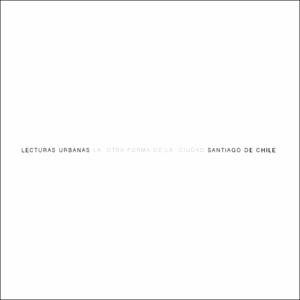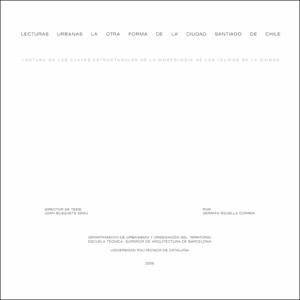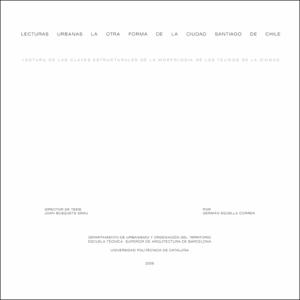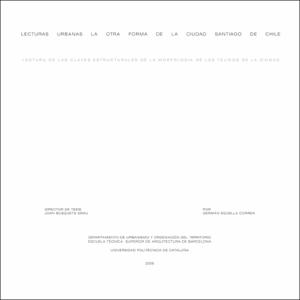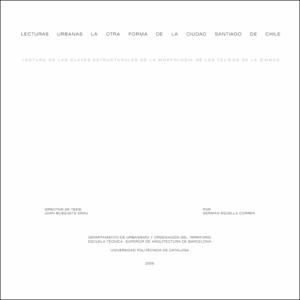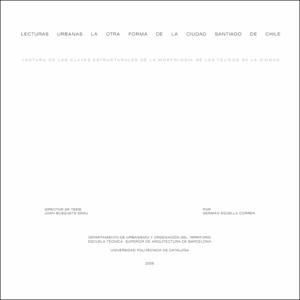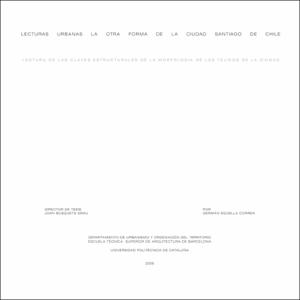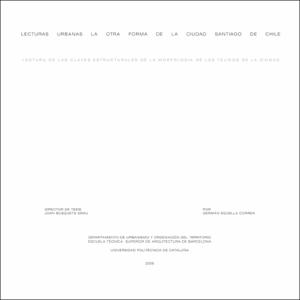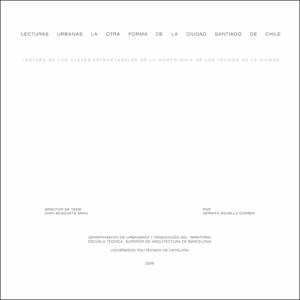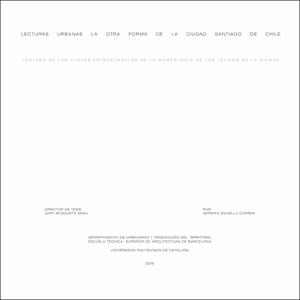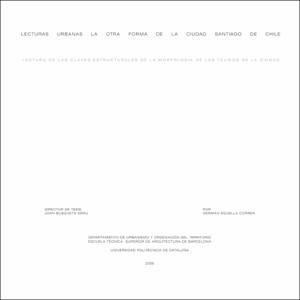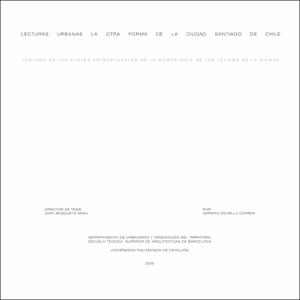Mostra el registre d'ítem simple
Lecturas urbanas : la otra forma de la ciudad Santiago de Chile
| dc.contributor | Busquets Grau, Joan |
| dc.contributor.author | Squella Correa, Germán |
| dc.contributor.other | Universitat Politècnica de Catalunya. Departament d'Urbanisme i Ordenació del Territori |
| dc.coverage.spatial | east=-70.70147780000002; north=-33.42495709999999; name=Santiago de Chile, Región Metropolitana, Chile |
| dc.date.accessioned | 2011-04-12T15:30:56Z |
| dc.date.available | 2009-06-02 |
| dc.date.issued | 2006-10-31 |
| dc.date.submitted | 2009-06-02 |
| dc.identifier.citation | Squella Correa, G. Lecturas urbanas : la otra forma de la ciudad Santiago de Chile. Tesi doctoral, UPC, Departament d'Urbanisme i Ordenació del Territori, 2006. ISBN 9788469240588. DOI 10.5821/dissertation-2117-94288. |
| dc.identifier.isbn | 9788469240588 |
| dc.identifier.other | http://www.tdx.cat/TDX-0602109-094648 |
| dc.identifier.uri | http://hdl.handle.net/2117/94288 |
| dc.description.abstract | Abastract<br/><br/>This thesis is a first step that intends to interpret, by observing different urbanizations of the city of Santiago, which are the formal characteristics thereof, and how they determine the city's final shape.<br/><br/>Thus, the purpose is to recognize the morphology of the urbanizations by identifying their different structures in order to establish categories that will allow construing the urban shapes related to the periods during which the city has developed. Common reading of the whole development of the city subsequent to the foundation process contrasts with the infinity of situations that intertwine operations of new urbanizations with existing occupations. This gives rise to the initial question of this research.<br/><br/>What shape has taken the city of Santiago? <br/><br/>This question may be approached from two standpoints; first, from the description of the historical expansion process of Santiago, and second from the reading of the structural keys of the city's urbanization morphology; to this end, four aspects have been established for development of the same.<br/><br/>The shape of the expansions, and the historical urban facts that have contributed to the city's development.<br/><br/>The readings recognizing the city as a whole.<br/><br/>The sectors considered as critical in Santiago.<br/><br/>The formal characteristics of the urbanizations of the city.<br/><br/>The shape of the urbanizations is possibly the actual shape of the city. Each urbanization maintains different levels of autonomy but in turn each finds its way to be intertwined to the others. Santiago has a first foundational urbanization that, when looking at its long transformation process, has determinant formal characteristics. The regular weave and well-defined homogeneity does not manage to extend directly beyond its boundaries, but constitutes the city's distribution principle, which will be repeated in time but will never have the same characteristics again.<br/><br/>After its foundation, the city underwent a long expansion process that is far from the formal characteristics of the original urbanization and struggles in an expansion which extends across the territory, starting a new process that, although related with the former, describes a transformation of the block layout and morphology, followed by an expansion having new elements and different operations proper of the urban development of the city of Santiago.<br/><br/>This study is focused on collecting the elements that give shape to the urbanizations and on observing how they intertwine with the city as a whole. The intention is to interpret and recognize its formation process and relationship with the original layout by identifying first whether there is a formal transference to the new urbanizations during the different expansion periods of the city, and then, if such transference exists, how it takes place. <br/><br/>The city will be studied from the perspective of its urban shape and its expansion and transformation processes, as well as the ongoing variations affecting the same, which consists of reviewing and reexamining the shape of Santiago providing analysis material aimed at facilitating a new reading of the city.<br/><br/>Thus, the shape of the city will be reexamined through urban readings. |
| dc.description.abstract | Esta tesis es un primer paso que pretende interpretar, al observar las diferentes urbanizaciones de la ciudad de Santiago, cuáles son sus características formales y cómo determinan la forma final de la ciudad. Por lo tanto, el objetivo es reconocer la morfología de las urbanizaciones identificando sus diferentes estructuras con el fin de establecer categorías que permitan construir las formas urbanas relacionadas con los períodos durante los cuales la ciudad se ha desarrollado. La lectura común de todo el desarrollo de la ciudad después del proceso de fundación contrasta con la infinidad de situaciones que entrelazan las operaciones de las nuevas urbanizaciones con las ocupaciones existentes. Esto da lugar a la pregunta inicial de esta investigación. ¿Qué forma ha tomado la ciudad de Santiago? Esta pregunta se puede abordar desde dos puntos de vista; primero, a partir de la descripción del proceso de expansión histórica de Santiago, y segundo a partir de la lectura de las claves estructurales de la morfología de la urbanización de la ciudad; para este fin, se han establecido cuatro aspectos para el desarrollo de la misma. La forma de las expansiones y los hechos urbanos históricos que han contribuido al desarrollo de la ciudad. -Las lecturas que reconocen a la ciudad como un todo. -Los sectores considerados críticos en Santiago. -Las características formales de las urbanizaciones de la ciudad. La forma de las urbanizaciones es posiblemente la forma real de la ciudad. Cada urbanización mantiene diferentes niveles de autonomía, pero a su vez cada uno encuentra su camino para entrelazarse con los demás. Santiago tiene una primera urbanización fundacional que, al observar su largo proceso de transformación, tiene características formales determinantes. El tejido regular y la homogeneidad bien definida no logran extenderse directamente más allá de sus límites, pero constituye el principio de distribución de la ciudad, que se repetirá en el tiempo pero nunca volverá a tener las mismas características. Después de su fundación, la ciudad sufrió un largo proceso de expansión que dista mucho de las características formales de la urbanización original y lucha en una expansión que se extiende por todo el territorio, iniciando un nuevo proceso que, aunque relacionado con el primero, describe una transformación del diseño de bloques y morfología, seguido de una expansión con elementos nuevos y diferentes operaciones propias del desarrollo urbano de la ciudad de Santiago. Este estudio se enfoca en recolectar los elementos que dan forma a las urbanizaciones y en observar cómo se entrelazan con la ciudad como un todo. La intención es interpretar y reconocer su proceso de formación y relación con el diseño original identificando primero si hay una transferencia formal a las nuevas urbanizaciones durante los diferentes períodos de expansión de la ciudad, y luego, si tal transferencia existe, cómo se lleva a cabo . La ciudad se estudiará desde la perspectiva de su forma urbana y sus procesos de expansión y transformación, así como las continuas variaciones que afectan a la misma, que consiste en revisar y reexaminar la forma de Santiago proporcionando material de análisis para facilitar una nueva lectura de la ciudad. Por lo tanto, la forma de la ciudad será reexaminada a través de lecturas urbanas |
| dc.language.iso | spa |
| dc.publisher | Universitat Politècnica de Catalunya |
| dc.rights | ADVERTIMENT. L'accés als continguts d'aquesta tesi doctoral i la seva utilització ha de respectar els drets de la persona autora. Pot ser utilitzada per a consulta o estudi personal, així com en activitats o materials d'investigació i docència en els termes establerts a l'art. 32 del Text Refós de la Llei de Propietat Intel·lectual (RDL 1/1996). Per altres utilitzacions es requereix l'autorització prèvia i expressa de la persona autora. En qualsevol cas, en la utilització dels seus continguts caldrà indicar de forma clara el nom i cognoms de la persona autora i el títol de la tesi doctoral. No s'autoritza la seva reproducció o altres formes d'explotació efectuades amb finalitats de lucre ni la seva comunicació pública des d'un lloc aliè al servei TDX. Tampoc s'autoritza la presentació del seu contingut en una finestra o marc aliè a TDX (framing). Aquesta reserva de drets afecta tant als continguts de la tesi com als seus resums i índexs. |
| dc.source | TDX (Tesis Doctorals en Xarxa) |
| dc.subject | Àrees temàtiques de la UPC::Urbanisme |
| dc.subject.other | estructurales |
| dc.subject.other | Santiago de Chile |
| dc.subject.other | proyecto urbano |
| dc.subject.other | planeamiento urbano |
| dc.subject.other | ordenación del territorio |
| dc.subject.other | urbanismo |
| dc.subject.other | morfologia |
| dc.title | Lecturas urbanas : la otra forma de la ciudad Santiago de Chile |
| dc.type | Doctoral thesis |
| dc.subject.lemac | Urbanisme -- Xile -- Santiago |
| dc.subject.lemac | Ordenació del territori -- Xile -- Santiago |
| dc.subject.lemac | Desenvolupament urbà -- Xile -- Santiago |
| dc.subject.lemac | Política urbana -- Xile -- Santiago |
| dc.subject.lemac | Morfologia urbana -- Xile -- Santiago |
| dc.subject.lemac | Ciutats -- Xile -- Santiago |
| dc.identifier.doi | 10.5821/dissertation-2117-94288 |
| dc.identifier.dl | B.33023-2009 |
| dc.rights.access | Open Access |
| dc.description.version | Postprint (published version) |
| dc.identifier.tdx | http://hdl.handle.net/10803/6970 |


